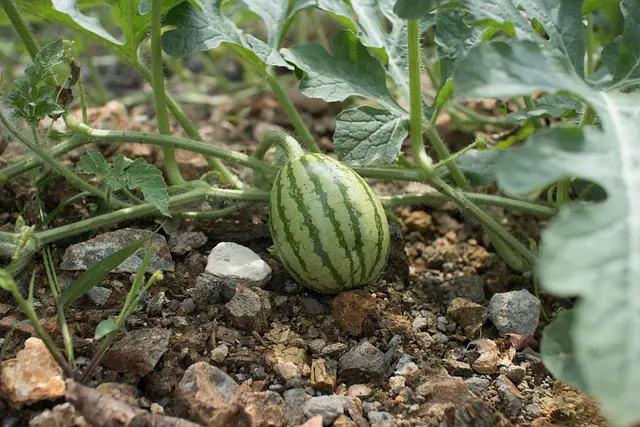You came to this article to learn how to grow watermelons in raised beds. It is great because this means you are not one of those fellows who believe Watermelon cannot be grown in raised beds. So you are on the right spot and we will discuss every detail regarding how to grow watermelon-raised beds.

Watermelon is the big, sweet, and juicy summer treat everyone loves. They are really easy to grow and they don’t need a lot of effort to grow unless you are growing them in a raised bed. In this case, you have to provide some extra care and effort to grow them properly.
Growing watermelon in raised beds is also a very easy job and you need to focus on a few things that we will discuss later in this article. Starting with the basics of how to grow watermelon we will cover every detail here.
How to Grow Watermelon
Growing watermelon is really easy. You can start with seeds or directly from seedlings. Watermelon loves warm climates to grow. So plant them so that they get at least three months of warm weather. They can be started from seeds indoors also. They grow on vines. You have to wait for 80 to 100 days from the start to harvest, depending upon the variety.
You can start growing with seeds but this could require more care. The success rate could also get a bit lowered in this case. Alternatively, you can start with the seedlings. They can be bought directly from some nursery or plant store. You may also need not wait for a longer time to get the harvest when you start with seedlings.
When to Plant Watermelon
As told before, watermelons love warm temperatures to grow, so you can start from seeds. Sow the seeds after a couple of weeks have passed since the last frost. This is for the places where the climate remains warm for a longer period of time. For the areas where summer is short, you can start seeds indoors before the last frost and later on transplant the seedlings into the garden.
Planting Watermelons
If you are planning to start with seeds indoors because of the short summers. I recommend you use biodegradable seed trays. Because baby plants have delicate root systems they don’t like to be disturbed. So it’s better to start them in biodegradable seed trays.
Fill the trays with a starting mix and sow two to three seeds per tray. This would increase the germination rate. After sowing the seeds, water them gently. Place the tray on a sunny spot to keep them a bit warmer. When you see the seedlings appear after a couple of weeks you need to keep only the strong-looking ones. Survival of the fittest is the rule here, you need to cut off the weak-looking plants.
Hardening off
If you grow the watermelon plants as told above, you need to harden them off. Once they are ready to be transplanted outside, place the young plants in a sunny location for an hour per day. Increase the exposure time gradually.
When you are starting directly from the seedlings, you may not need to harden off.
Grow Watermelon Raised beds
Once the stages told above have passed you can now transplant your watermelon plant into a raised bed. If you belong to a warm climate area, you can start by sowing seeds directly into the raised beds.
To get a handful of harvest you can start the plant in an 8 by 2 or 4 feet raised bed, either made from fabric, concrete, or wood. In this size of a raised bed, you can easily plant 12 plants of watermelon. Or you can half this number and grow any other plant in that space. It depends on how many plants you want to grow. The following tips should be followed to get the maximum results.
Soil Preparation for Watermelon
You should use nutrient-rich soil. Adding aged manure to the soil would also increase its nutrient level. Loamy, sandy, and well-drained soil is important. Drainage is not problematic when you are growing in raised beds but it’s better to be on the safer side. Keep your soil slightly acidic to neutral. The pH should be 6.0 to 7.5.
Your raised beds should be one and a half to two feet high. This would allow more deep soil. Watermelons have a strong and expanded root system. They would need a lot of space. One more thing to keep in mind is that you need to wait for the soil to get warm. Wait for the warm temperature to start growing the plant.
Site Selection
Your watermelons need a lot of direct sunlight, about 10 hours a day. Yes, they need a lot of full and direct sunlight. Choose the site of your raised bed where you have open space and nothing should block the sunlight. This amount of sunlight would also keep the temperature warm enough for watermelon.
Another thing to keep in mind is that watermelons grow on vines. They can grow in length up to 10 feet. You need to provide the vines with a large space. This way the vines will grow uninterrupted.
Watering the Watermelons
Watering is the key to producing juicy watermelons. At the early stages of seed germination, they need to be watered every day. Don’t let the soil get dry. At later stages, they need about two inches of water every week. You need to water them deeply. Keep your soil moist all the time but also don’t overwater. You need to water them even, once the fruit starts to form.
Using Trellises
Another good idea is to grow watermelons by using a trellis. You need a firm and sturdy trellis for this purpose as the fruit can grow really heavy. Fix the trellis in the north-south direction so that the plants get maximum sunlight every day.
Let The Plant Grow

As the vines start to grow taller you need to provide the room and allow them to grow further. Remove any hindrances. Your watermelon vines need to be trained to grow the right way. If you are growing on a trellis, tie the vines up with a trellis. This would keep them moving straight up.
If you are growing them directly in the raised beds, keep looking for the vines not to get mingled. This would cause problems in managing the plant at later stages. Especially if you are growing some other plants in the same raised bed.
Let the vines grow on the ground and whenever you see a new vine growing, just show it the way down. It will grow wherever you point it to grow. Provide enough ground for the vines to grow freely.
Support the Watermelons
As watermelons are considerably heavy fruits, they need to be managed accordingly. Even if you are growing them in raised beds with or without using a trellis. There is a chance of getting a hanging melon.
The weight of the fruit could stretch the main stem and this way your plant can get damaged. So you need to support your watermelon by using a sling. Put the watermelon in it and tie it to the trellis or wall of the raised bed. Make sure the stem should not bear the weight of the fruit.
Mulching
To retain the moisture level of your soil, mulch it well. Watermelon loves moist soil and mulching would keep it just as they want. Keep looking for weeds and remove them on time. Mulch with black plastic or straw. It would keep the soil temperature adjusted and it also helps to keep the fruit safe from rotting.
Fertilizing the Watermelon Plants
To keep the level of nutrients up in the soil, it needs to be fertilized. Adding compost to your soil would keep the deficiencies away from your soil. Aged manure can also be added to the soil as this would also prove to be very beneficial.
You should also keep testing the soil for any shortcomings. Nitrogen, phosphorus, and potassium levels should be up to the mark. Using all-purpose balanced fertilizer is also a very good option. It is NPK 4-4-4.
Harvesting the Watermelons
It is now the time to harvest your fruit. Watermelons need to be harvested right at the time when they rip. Delay in the harvest could spoil them. So keep an eye on them as soon as they get mature.
After the maturity stage, check the watermelons daily. The best thing to do is to count the number of days from seed planting to harvest. You should know how long the variety you are growing takes to fully mature.
You can also know when your fruit is ripe by a few symptoms. If the tendril that is close to the stem gets brown and dry or the leaves start to get brown, it could be time to harvest. The Lower side of the watermelon turns yellow, or the skin color will turn dull, these are also the indicators that your fruit is fully ripe now.
You can also test your fruit by scratching it with your nail. But this is a risky thing to do as it can cause bacteria to enter the harvest.
Storing The Fruit
It’s preferred to eat freshly harvested watermelons as nothing beats the taste of freshness. You should look for the ones having cracks, they should be consumed earliest. A good thing is that you can also store the harvest for later use.
At room temperature, the watermelons could last for up to ten days. If you want to preserve them for a longer time, freezing, drying, and canning techniques could be used. This way they can be stored for a much longer period of time.
YOU MAY ALSO LIKE
How To Grow Cherry Tomatoes From Cherry Tomatoes

